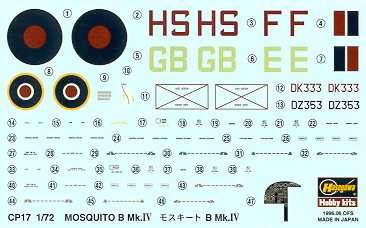
|
KIT: |
Hasegawa 1/72 Mosquito B.IV |
|
KIT # |
51217 (CP 17) |
|
PRICE: |
$19.98 |
|
DECALS: |
Two Aircraft |
|
REVIEW & |
|
|
NOTES: |

|
HISTORY |
Name four exceptional British WWII aircraft and one of those will be the Mosquito. Developed to make the most of non-strategic resources, the airframe is mostly made of wood. Thanks to the high level of construction and the smoothness of the wood, the Mossie proved to be an exceptionally fast aircraft. So much so that it was decided not to fit it with any defensive armament. It soon went on to prove itself capable of excelling in any role that it was given, and those roles were many. It was a day fighter, night fighter, ground attack , reconnaissance, bomber, target tug, high speed airliner, and was also developed for aircraft carrier usage.
Despite its wooden construction, it was widely exported after the war to many countries around the world. Even today, there are several airframes still flying in the hands of warbird owners.
|
THE KIT |

Several years ago, Hasegawa undertook a program of building, in 1/72, a rather extensive line of twin engined WWII aircraft. They started with Japanese types and produced such aircraft as the Ki-49, G3M, Ki-45, P1Y, and Ki-67 to name a few. Recently this has spread to RAF types with the Beaufighter and now the Mosquito.
This particular kit is of the initial bomber variant, the B.IV. In order to get the most out if its molding costs, this kit has a number of subassemblies and is broken down in such a way to allow a large number of variants to be built. As such it makes for a very parts intensive and fiddly-looking kit. Hasegawa is not to blame for this as many kit makers are doing the same thing. One benefit is that it gives you a number of optional bits that, if not used on this kit, can be used elsewhere.
You get the usual high standard of molding that one has come to expect from Hasegawa. There is a full cockpit with a decal for the instrument panel, a standard of Hasegawa 1/72 kits. You also get a full bomb bay and bomb load. This subassembly has wing spars that fit through the fuselage to help hold on the wings. A nice touch. The nose section is separate from the rest of the airframe to allow for upcoming boxings of the kit. There are two different props included, pointed and paddle bladed types. Only shrouded exhausts are given. The canopy is split into left and right halves. I imagine there was a reason for doing this, but it does make filling the inevitable seam a bit difficult. My kit was missing a prop spinner. A letter has been sent to Hasegawa requesting a replacement and one was provided within two weeks. That is what customer support should be like everywhere!
 The instructions are excellent and up
to Hasegawa's usual standard. Paint callouts are given for Gunze as is also the
norm. Two decal options are provided. One is for a 109 Squadron aircraft from
Jan 1943. HS*F is Dark Green and Ocean Grey over Black and is the plane shown on
the box art. The other is GB*E from 105 Squadron in late 1942. This aircraft has
the Light Aircraft Grey undersides. The decals are very well printed, though
like most Hasegawa kit decals are a bit thick and may be a challenge to properly
use.
The instructions are excellent and up
to Hasegawa's usual standard. Paint callouts are given for Gunze as is also the
norm. Two decal options are provided. One is for a 109 Squadron aircraft from
Jan 1943. HS*F is Dark Green and Ocean Grey over Black and is the plane shown on
the box art. The other is GB*E from 105 Squadron in late 1942. This aircraft has
the Light Aircraft Grey undersides. The decals are very well printed, though
like most Hasegawa kit decals are a bit thick and may be a challenge to properly
use.
It looks as if it will build into a very nice kit and is sure to add something to your model collection.
Review kit courtesy of me and my wallet!
If you would like your product reviewed fairly and quickly by a site that averages over 2,500 visits a day, please contact me or see other details in the Note to Contributors.